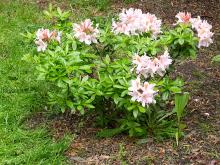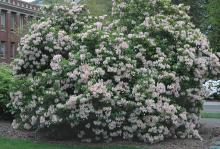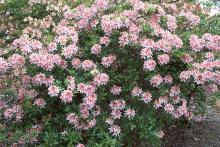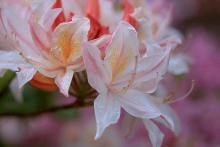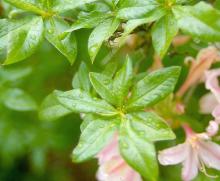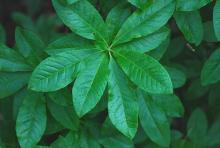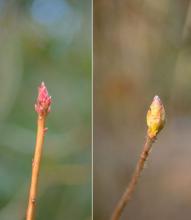Rhododendron occidentale
Common name:
Western Azalea
Pronunciation:
ro-do-DEN-dron ok-ci-den-TAH-lee
Family:
Ericaceae
Type:
Broadleaf
Native to (or naturalized in) Oregon:
Yes
- Deciduous shrub, 10 ft (3 m), compact, upright. Leaves 3-9 cm long, elliptic or oblong-lanceolate, upper side glossy green, underside pubescent; in fall leaves may turn yellow, scarlet or crimson. Blooms at or after leaf emergence. Flowers are white, orange-pink or red in the bud, opening to white or salmon pink, usually with stripes, and a faint yellow blotch (sometimes absent) on the upper lobe, 5 stamens, broad funnel form, 3-5 cm wide, generally 6-12 flowers per cluster, very fragrant.
- - 5°F, mid to late, 4/3/3 [flower / plant & foliage / performance; scale 1 (poor) - 5 (best)]. Sun to part shade.
- The only azalea native to west of the Rocky Mountains. Found along the Pacific Coast from southwestern Oregon to southern California; found along stream banks and moist areas in woods. Has been extensively used in hybridizing, especially to add fragrance.
- Several selections have been made, including (Galle, 1985):
- ‘Leonard Frisbee’ - a natural selection (Mossman & Smith), compact shrub, 4 × 4 ft (1.2 × 1.2 m), flowers light red with a orange-yellow flare, tubular funnel shape, 7.5 cm, about 20 flowers per cluster; hardy to -15°F.
- ‘Pistol Pete’ - a natural selection (Slonecker), upright, 6 × 4 ft (1.8 × 1.8 m), flowers pale greenish yellow, lobes small and cut to the base, about 1 cm long and 2.5 cm wide, pistilate form (no stamens), 17-21 flowers per cluster; hardy to 0o F.
- ‘Rouge River Belle’ - (Frisbie) flowers white with pink markings, yellow blotch, 6 cm across.
- ‘Stagecoach Frills’ - (Mossman & Smith) flowers white, strong yellow blotch, frilled margins.
- There are also a number of Occidental Hybrids, most of the initial ones were developed by M. Koster & Sons of Holland in about 1895 from crosses between R. occidentale and Mollis hybrids. C. G. Bower, in his book on Rhododendrons and Azaleas (1960, p. 417) states that "the natural forms of R. occidentale bear little resemblance to the clone under that name grown in Holland". He considers the group designation [Occidental Hybrids] of "doubtful validity" and "prefers the name 'Albicans', which goes back the original Waterer cross of R. occidentale × molle." More recently other hybridizers, such as L. F. Frisbee, F. D. Mossman and B. Smith in Washington State, have introduced additional "Occidental hybrids" using other parental material. Some of the more highly regarded Occidental hybrids include:
- ‘Delicatissimum’ - (Koster) pale yellowish white, flushed with pink, yellow blotch, fragrant. RHS Award of Garden Merit 1993.
- ‘Exquisitum’ - (Koster, 1901) flesh pink, flushed deep pink on the outside, orange flare, frilly margins, fragrant. RHS Award of Garden Merit 1993.
- ‘Irene Koster’ - (Koster) rose pink with small yellow blotch, late. RHS Award of Garden Merit 1993.
- ‘Magnificum’ - (Koster, 1910) creamy white, flushed pink, orange flare, rose flushed bud, fragrant.
- ‘Summer Fragrance’ - (R. occidentale × R. luteum, Pratt, 1963) pale yellow with vivid yellow blotch, fragrant, blooms early summer, compact shrub, good fall color. RHS Award of Garden Merit 1993.
- ‘Westminster’ - (Koster) clear rich almond-pink with faint orange flare.
- Oregon State Univ. campus: southwest corner of Nash; southeast of Gilkey Hall at intersection of sidewalks.

